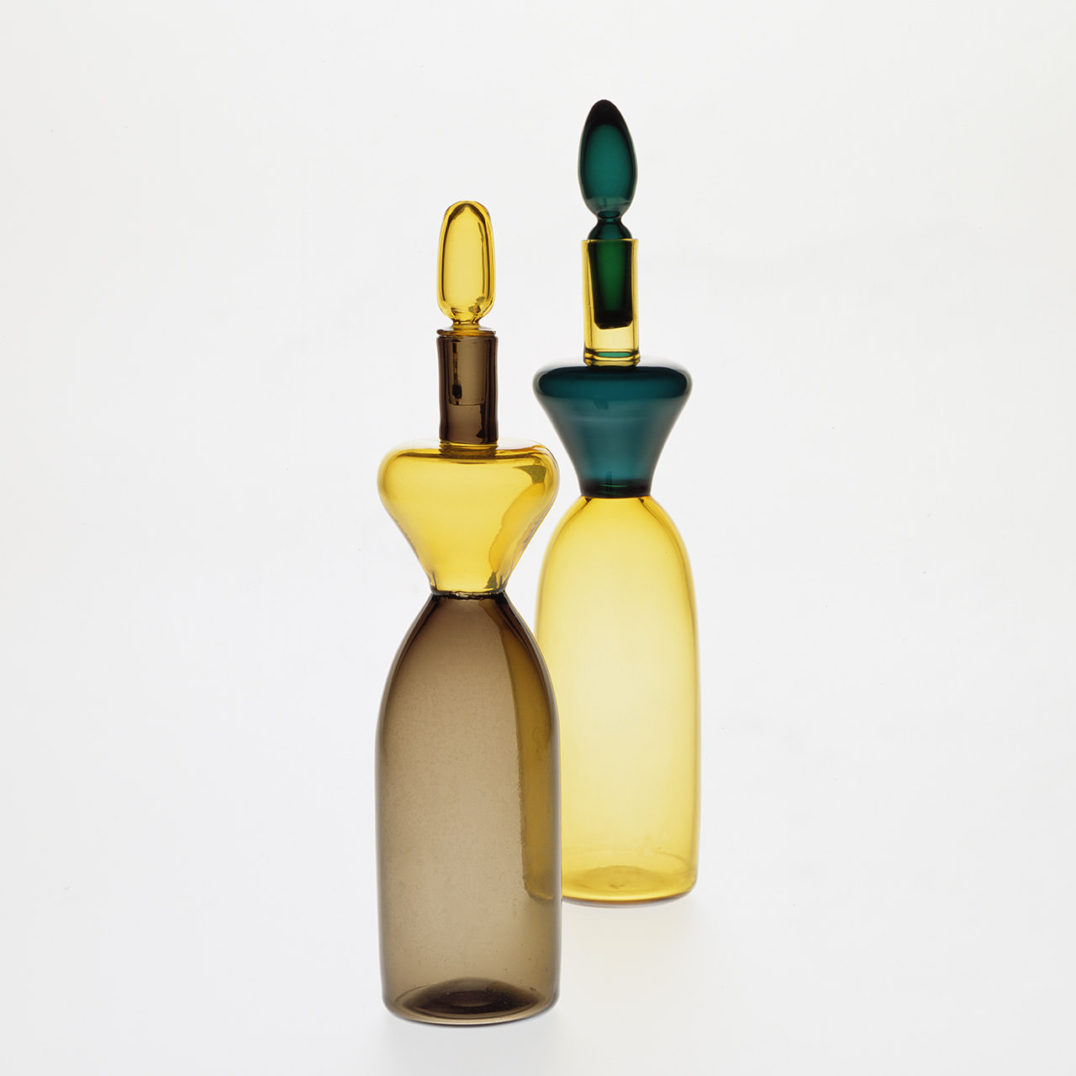
Giò PontiBottiglie morandiane, 1946–1950
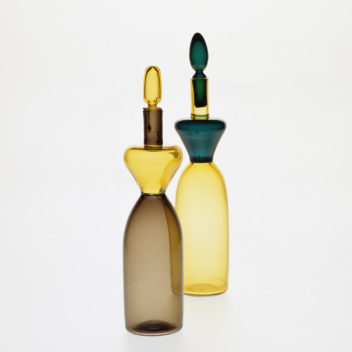
Giò PontiBottiglie morandianeVenini & C., 1946–1950
Two stoppered incalmo bottles from the Morandiane series. One is straw and light aubergine glass with a straw colored stopper, the other is straw and blue glass with a a blue stopper.
Acid stamped:
venini murano ITALIA.
13 1/2 in. high (34 cm)
13 1/2 in. high (34 cm)
Bibliography and comparative texts:
R. Linzeler, 1922, p. 666;
C. Carrà, 1923, p. 67;
R. Linzeler, 1923, p. 83;
R. Papini, 1930, n. 570;
G. Mariacher, 1967, p. 98;
R. Barovier Mentasti, 1982, n. 252;
Mille anni…, 1982, n. 503;
F. Deboni, 1984, p. n. 70;
W. Neuwirth, 1987, nn. 7, 104;
A. Dorigato, 1986, p. 71;
F. Deboni, 1989, n. 1;
L’arte del vetro, 1982, n. 307;
M. Heiremans, 1993, n. 191;
M. Barovier, R. Barovier Mentasti,
A. Dorigato, 1995, n. 15;
A. Venini Diaz de Santillana, 1996, n. 1;
R. Barovier Mentasti, 1998, n. 25;
A. Venini Diaz de Santillana, 2000, n. 1;
Olnick Spanu, 2000, n. 8;
Olnick Spanu, 2001, n. 13.
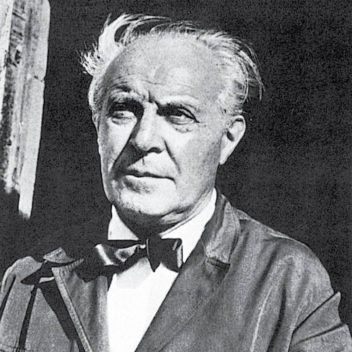
Giò Ponti 1891–1979
Giò Ponti was born in Milan. After graduating from the Architecture School in Milan, he dedicated himself to architectural design and the decorative arts, a field to which he brought significant innovation. His furniture design and his work for the porcelain manufacturer Richard Ginori, where he was an artistic consultant from 1923 to 1938, were widely acclaimed. In 1928, he founded the prestigious magazine Domus, an effective instrument for the diffusion of contemporary architectural and figurative culture. He was also one of the founders of the group Il Labirinto, which organized the first Triennali di Monza, later to become part of the Triennale di Milano. A close friend of Paolo Venini, they collaborated in experimenting with new styles and trends (forme nuove). He commissioned several lighting installations from Venini and entrusted him with the making of major stained glass windows. In 1946, he himself designed a refined collection of glass pieces for Venini: among them is the bottle with applied spiral (also made in porcelain by Richard Ginori) and the series of colored bottles and goblets a canne.
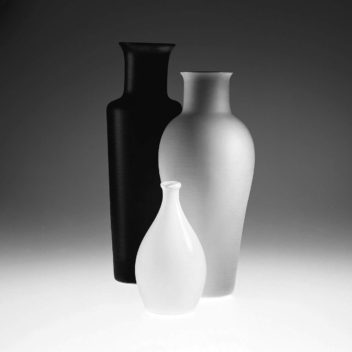
Venini & C. 1932–2001
In 1932, when both Martinuzzi and Zecchin left the company, Paolo Venini changed the name from Vetri Soffiati Muranesi Venini & Co. (V.S.M. Venini & Co.) to Venini & C.. Milanese architect Tommaso Buzzi became the new artistic director. After 1934, artistic direction was taken on by Carlo Scarpa, who designed most of the company's production through 1947. Side by side with Venini, who often intervened personally in design, Scarpa created numerous collections of objects characterized by refined colors. After World War II, Venini & C. sought numerous collaborations with artists such as architect Giò Ponti and the Swedish-born Tyra Lundgren. After 1948, Fulvio Bianconi, Massimo Vignelli, and Tobia Scarpa contributed significantly to the new direction of the company. Paolo Venini died in 1959 and his son-in-law, Ludovico Diaz de Santillana, took over the management of Venini & C. He not only worked personally as a glass designer but also continued the collaboration started by Paolo Venini with various artists and designers. Starting in 1960, many other designers collaborated with the company, like Thomas Stearns, Toni Zuccheri, Tapio Wirkkala, Laura and Alessandro Diaz de Santillana, James Carpenter, Dan Dailey, Richard Marquis, Benjamin Moore, and Toots Zynsky. In 1986, the de Santillana family left the company, selling their stock to the Ferruzzi group, which guaranteed the fine quality Venini was known for by hiring new designers such as Timo Sarpaneva, Marco Zanini, Ettore Sottsass Jr., Alessandro Mendini, Mario Bellini, Barbara del Vicario, and others. In 1988, Venini was acquired by Royal Scandinavian. Since 2001, Venini S.p.A. has been part of Italian Luxury Industries Group and is led by Giancarlo Chimento, Giuliano Tabacchi, and Giorgio Rizzo.
Giò PontiBottiglie morandiane, 1946–1950
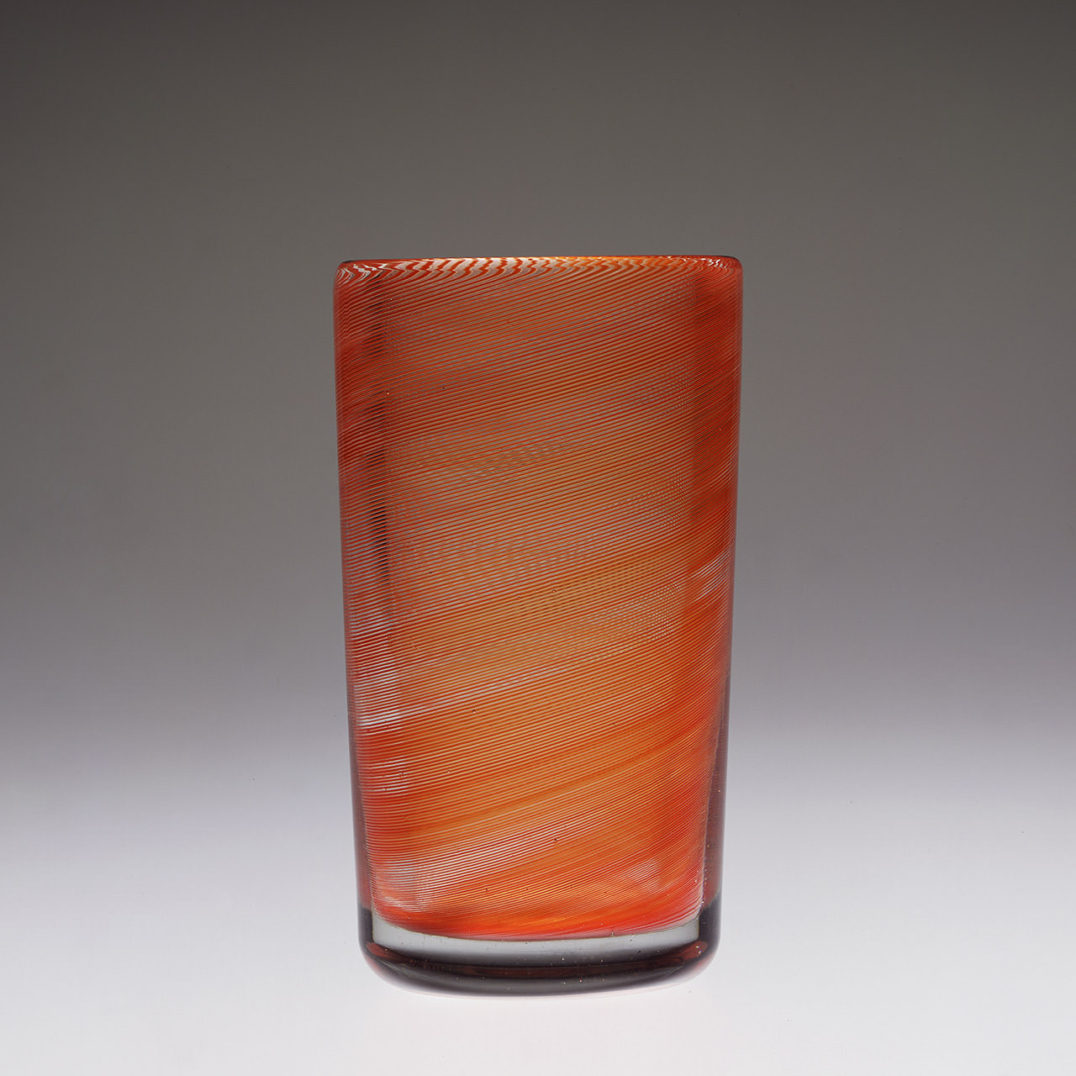
Carlo ScarpaMezza filigrana, 1934–1936
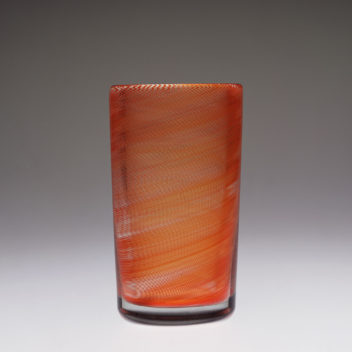
Carlo ScarpaMezza filigranaVenini & C., 1934–1936
A red a mezza filigrana vase sommerso in cristallo.
Acid stamped:
venini murano.
7 1/2 in. high (19 cm)

Carlo Scarpa 1906–1978
Born in Venice, Carlo Scarpa graduated from the Accademia di Belle Arti in Venice in 1926. Soon after his graduation he began work at M.V.M. Cappellin, where he soon replaced Vittorio Zecchin as artistic director. Following the direction laid down by Zecchin, he initially created transparent blown-glass pieces with essential forms, in particular the pieces exemplified by their conic base. Scarpa later designed light glass pieces in brightly colored pasta vitrea, or decorated fenici. Deservedly famous was the refined collection of lattimi decorated with gold or silver leaf, which he presented for the first time in Monza in 1930 together with the canne verticali and millefiori glass works. Giacomo Cappellin closed the workshop in 1932 for bankruptcy, putting an end to the collaboration with Carlo Scarpa. In 1934, Scarpa became the artistic director of Venini & C., where he continued to work through 1947. Alongside Paolo Venini, who often participated in the design of glass, Carlo Scarpa experimented with the vast potential of glass, using and innovating many traditional techniques, by which he created extraordinary modern pieces. After the mezza filigrana glass works came the sommersi, the pasta vitrea inspired by Chinese ceramic motifs, the corrosi, the battuti, the vessels a fasce colorate, a pennellate, the variegati, and the famous multicolored murrine with the surfaces finished at the carving wheel. After World War II, Carlo Scarpa worked almost exclusively as an architect and teacher.

Venini & C. 1932–2001
In 1932, when both Martinuzzi and Zecchin left the company, Paolo Venini changed the name from Vetri Soffiati Muranesi Venini & Co. (V.S.M. Venini & Co.) to Venini & C.. Milanese architect Tommaso Buzzi became the new artistic director. After 1934, artistic direction was taken on by Carlo Scarpa, who designed most of the company's production through 1947. Side by side with Venini, who often intervened personally in design, Scarpa created numerous collections of objects characterized by refined colors. After World War II, Venini & C. sought numerous collaborations with artists such as architect Giò Ponti and the Swedish-born Tyra Lundgren. After 1948, Fulvio Bianconi, Massimo Vignelli, and Tobia Scarpa contributed significantly to the new direction of the company. Paolo Venini died in 1959 and his son-in-law, Ludovico Diaz de Santillana, took over the management of Venini & C. He not only worked personally as a glass designer but also continued the collaboration started by Paolo Venini with various artists and designers. Starting in 1960, many other designers collaborated with the company, like Thomas Stearns, Toni Zuccheri, Tapio Wirkkala, Laura and Alessandro Diaz de Santillana, James Carpenter, Dan Dailey, Richard Marquis, Benjamin Moore, and Toots Zynsky. In 1986, the de Santillana family left the company, selling their stock to the Ferruzzi group, which guaranteed the fine quality Venini was known for by hiring new designers such as Timo Sarpaneva, Marco Zanini, Ettore Sottsass Jr., Alessandro Mendini, Mario Bellini, Barbara del Vicario, and others. In 1988, Venini was acquired by Royal Scandinavian. Since 2001, Venini S.p.A. has been part of Italian Luxury Industries Group and is led by Giancarlo Chimento, Giuliano Tabacchi, and Giorgio Rizzo.
Carlo ScarpaMezza filigrana, 1934–1936
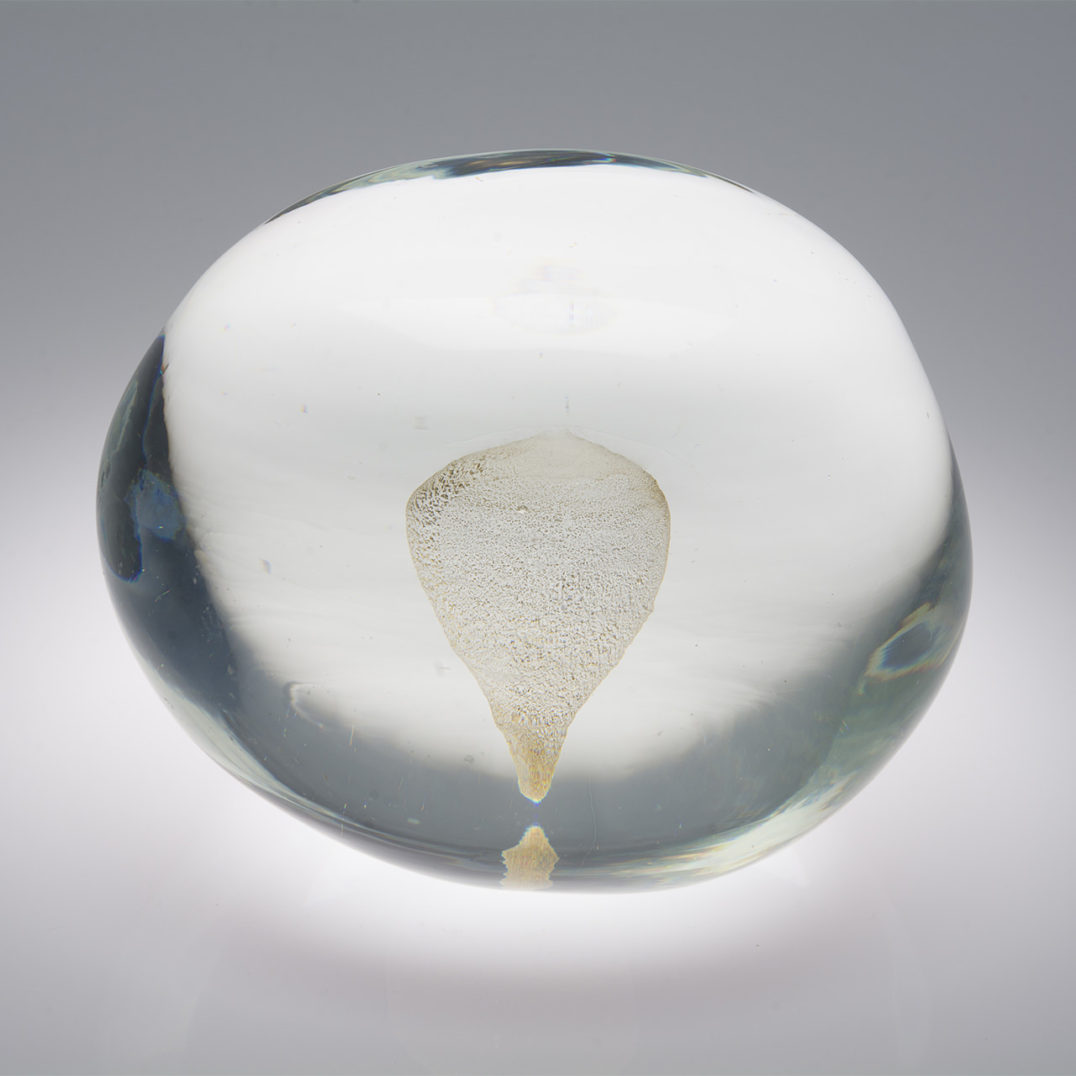
Patrizia MolinariSasso Nancy, 2001
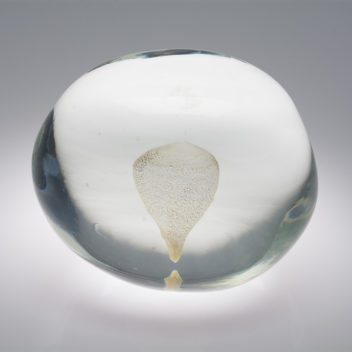
Patrizia MolinariSasso Nancy
Secret Stones series.
Stone shaped glass sculpture composed of transparent, free hand blown Murano glass with the inclusions of pure gold leaf.
Sasso Nancy is a gift from the artist to Nancy Olnick.
Signed and dated. Engraved “Patrizia Molinari 2001”

Patrizia Molinari 1948–
Born in Senigallia, Patrizia Molinari studied Modern Literature and Languages and Foreign Contemporary Literature at the University of Bologna. She received her Doctorate in Fine Arts at Urbino University. She started painting in 1974, researching the path of white and monochrome, and studying their interaction with light. Soon, light itself became the substance she chose to work with. She designed sculptures made with fiber optics and gun-light or glass, to her the materials closest conceptually to light itself. She designed huge installations of industrial glass—as big as 50 square meters—resting the sculptures on cutting edge splinters or placing them on the ceiling where they are then reflected in mirrors surrounded by glass-debris. Her work in Murano with Vetreria Campanella using the lost-wax process produced great projects including installations at Palazzo Ducale for Venezia Aperto Vetro 1998 and the Biennale of Venice 2001. Her series Sassi Segreti has been exhibited in Italy and London. She is renowned for these small-size Murano glass sculptures blown at canna volante, which are published in many glass books. Her work is part of the collection of major museums including the Museo Nazionale di Murano, which houses her masterpiece Mare Nostrum. Molinari won three first prizes in Open National Competitions with her glass fountains projects. She has exhibited in Italy, Europe, the United Arab Emirates, and the United States. Her obelisk of steel and gun-light, Towards Space, rests in Rome. She currently lives and works in Rome, where she has been the Chair of History of Fine Arts at the Academy of Fine Arts since 1976.
Patrizia MolinariSasso Nancy, 2001
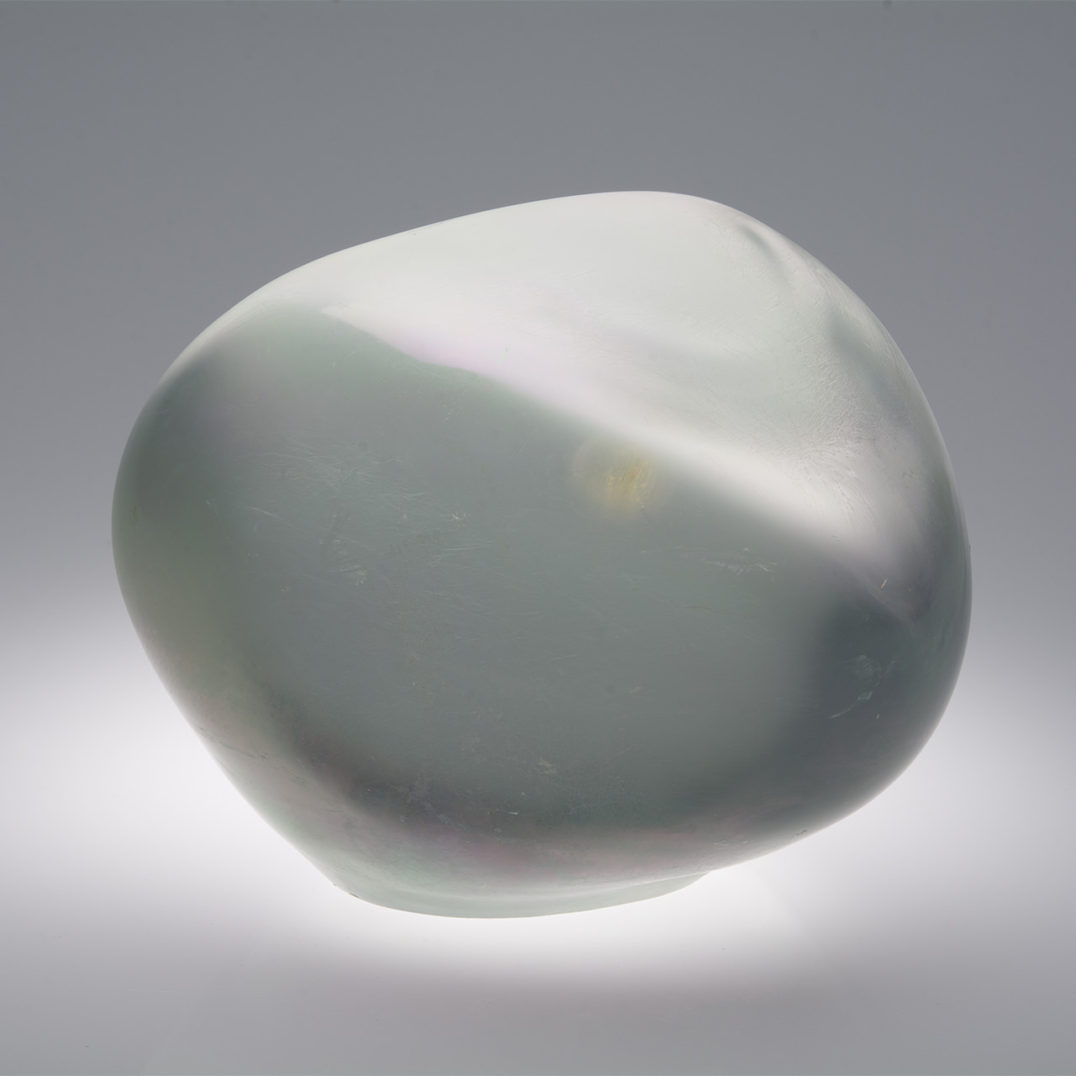
Patrizia MolinariSasso Giorgio, 2001
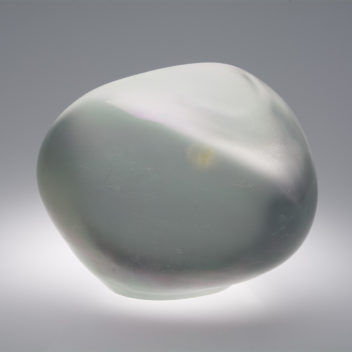
Patrizia MolinariSasso Giorgio
Secret Stones series.
Stone shaped glass sculpture composed of transparent, free hand blown Murano glass with the inclusions of pure gold leaf.
Sasso Giorgio is a gift from the artist to Giorgio Spanu.
Signed and dated. Engraved “Patrizia Molinari 2001”

Patrizia Molinari 1948–
Born in Senigallia, Patrizia Molinari studied Modern Literature and Languages and Foreign Contemporary Literature at the University of Bologna. She received her Doctorate in Fine Arts at Urbino University. She started painting in 1974, researching the path of white and monochrome, and studying their interaction with light. Soon, light itself became the substance she chose to work with. She designed sculptures made with fiber optics and gun-light or glass, to her the materials closest conceptually to light itself. She designed huge installations of industrial glass—as big as 50 square meters—resting the sculptures on cutting edge splinters or placing them on the ceiling where they are then reflected in mirrors surrounded by glass-debris. Her work in Murano with Vetreria Campanella using the lost-wax process produced great projects including installations at Palazzo Ducale for Venezia Aperto Vetro 1998 and the Biennale of Venice 2001. Her series Sassi Segreti has been exhibited in Italy and London. She is renowned for these small-size Murano glass sculptures blown at canna volante, which are published in many glass books. Her work is part of the collection of major museums including the Museo Nazionale di Murano, which houses her masterpiece Mare Nostrum. Molinari won three first prizes in Open National Competitions with her glass fountains projects. She has exhibited in Italy, Europe, the United Arab Emirates, and the United States. Her obelisk of steel and gun-light, Towards Space, rests in Rome. She currently lives and works in Rome, where she has been the Chair of History of Fine Arts at the Academy of Fine Arts since 1976.
Patrizia MolinariSasso Giorgio, 2001
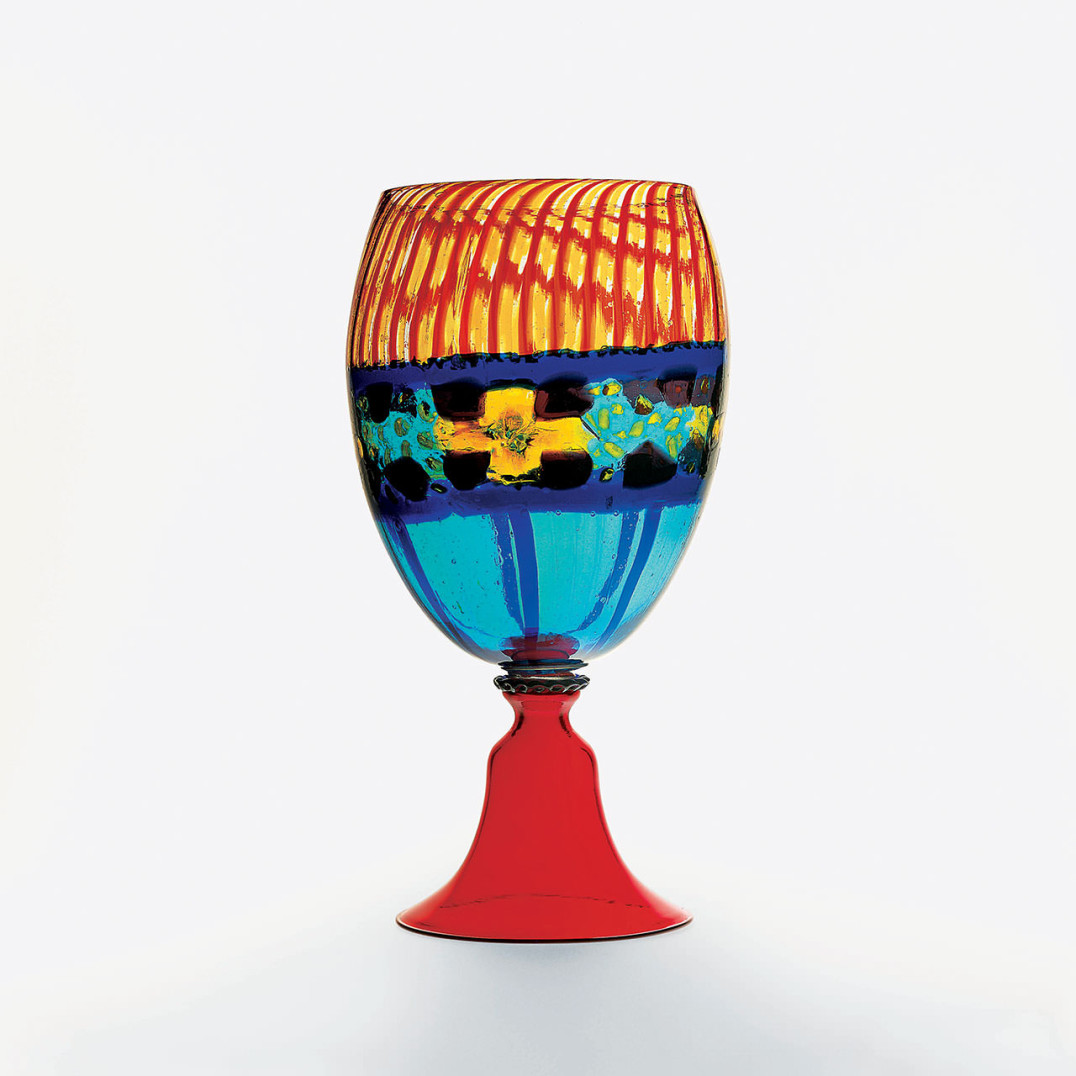
Salviati & C.A murrine, ca. 1914
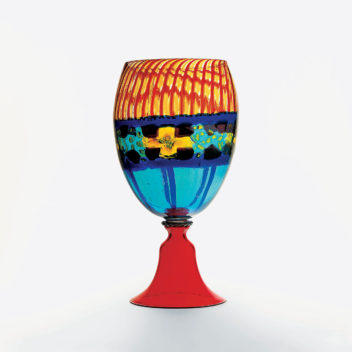
A murrineSalviati & C., ca. 1914
Tall glass chalice made of turquoise and blue, and red and yellow canes decorated at the center with a wide stripe of murrine creating a floral pattern. Tall foot in red trasparente glass. This object is part of a limited series of one-of-a-kind pieces crafted by Artisti Barovier for Salviati.
17 in. high (43.2 cm)
Exhibitions:
2001, Milan, Murano: Vetri dalla Collezione Olnick Spanu,
Spazio Oberdan.
Bibliography and comparative texts:
Antonio Salviati…, 1982, n. 77;
Vetro di Murano…, 1982, n. 99; Mostra del vetro…, 1984, n. 107;
C. Cerutti, 1985, p. 61;
I. De Guttry, M.P. Maino,
M. Quesada, 1985, n. 7;
Gli anni di…, 1987, nn. 19, 36;
M. Barovier, 1993, nn. 35-42;
M. Heiremans, 1993, nn. 30, 31;
M. Barovier, 1994, n. 2;
F. Deboni, 1996, n. 21;
Olnick Spanu, 2001, n. 1.

Salviati & C. 1877–
In 1859, Antonio Salviati, a lawyer, founded the “Salviati Dott. Antonio fu Bartolomeo” furnaces. With the help of Lorenzo Radi and Enrico Pondio, he developed a new method of making mosaic with glass. The mosaic tesserae that decorate the dome of St. Paul’s Cathedral and the Hall of the House of Parliament in London, the Opera Theatre in Paris, and many others were made by Salviati. In 1877, Salviati founded Salviati & C. in Murano, employing some of the best glass masters operating at that time: Antonio Camozzo and the talented Giovanni, Giuseppe, Benvenuto and Benedetto Barovier. They created a collection of glasses, stemware, bowls, chandeliers and vases, and a range of etched pieces. Salviati, who was known for his innovation, is recognized for the rediscovery of the avventurina, a fiamma, and opalino types of glass. Antonio Salviati died in 1890 and at the beginning of the 20th century the company became property of Maurizio Camerino, a young glassmaker who had started his craft at Salviati & C. During the 1930s, the Camerino family decided to abandon the production of mosaic to focus on the making of decorative objects and lighting. In the 1950s, with Luciano Gaspari as the new artistic director of Salviati & C., the company developed frequent collaborations with architects such as Sergio Asti, Romano Chirivi, and Vinicio Vianello, as well as with international designers such as Heinz Oestergaard and Claire Falkenstein. Today, Salviati remains one of the most representative companies for glassmaking in the world and continues to establish collaborations with many inspiring designers.